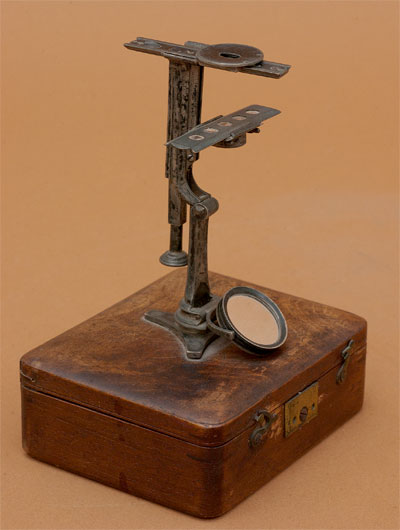 |
|||||
 |
 |
||||
 |
|||||
 |
 |
||||
This microscope has a screw thread focus mechanism that moves the stage mounting block up or down. The focus knob descends from the upper support. At the base of the microscope is a single sided plane mirror. The box is probably not original, but rather a 19th Century case made for a Gould-type instrument. On the back of the upper support is engraved in script John Clark Inv. Fec. Edinb. The microscope is 9.5cm tall.
John Clark was an optical instrument maker, jeweller, and goldsmith whose shops were located in Edinburgh Scotland between 1749 and 1796. He was the second earliest Scottish microscope maker (John Finlayson was the first in 1743) and produced high-quality instruments that optically were much better than compound microscopes at the time. Clark first offered microscopes, made in silver, for sale in 1749, subsequently modifying their design in 1754, and ultimately advertising a brass instrument in 1773. John Clark had at least three shops: one at James Gilliland's Jeweller, at the upper-end of the Luckenbooths (1749); one at Parliament Close (1751-55); and one at Sir Isaac Newton's Head, a little above the Guard, north side of the High Street (1773-82). The microscope shown here was made at his location on High Street in Edinburgh.
The microscope is a modification of Clark's "New Silver Microscope" of 1754; an example of which is in the Royal Scottish Museum. The fact that this microscope is silver plated made it more expensive to buy and therefore more rare than his other brass examples.
This instrument is an example of John Clark’s first foray into microscope design, first made and sold on subscription in 1749, and again advertised for sale in 1751. It is a precursor to his second silver microscope – also first made under a subscription process in 1754 – and the brass instrument again initially sold on a subscription basis in 1773. It is the sole surviving example known (D.J.Bryden BSc MA PhD FSA*).
*‘Three Edinburgh Microscope Makers: John Finlayson, William Robertson and John Clerk’, Book of the Old Edinburgh Club, 33 (1972), 165-76. –see plate 6, fig a
Featured 03/2013, 12/2019
